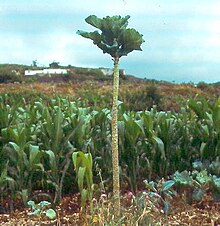| Jersey cabbage | |
|---|---|
 Jersey cabbage can be cultivated to grow quite large, especially in frost-free climates | |
| Species | Brassica oleracea longata |


The Jersey cabbage (Brassica oleracea longata) is a variety of cabbage native to the Channel Islands that grows to a great height and was formerly commonly used there as livestock fodder and for making walking sticks. It is also known as Jersey kale or cow cabbage,[1] and by a variety of local names including giant cabbage,[1] long jacks, tree cabbage and the French chour and chou à vacque.
The 'Jersey cabbage' develops a long stalk, commonly reaching 6 to 10 feet (1.8 to 3.0 m) in height, and can grow as tall as 18 to 20 feet (5.5 to 6.1 m).[2][1][3] Historically the stalks were made into walking sticks, of which 30,000 a year were being sold by the early 20th century, many for export.[4][5] They were also used for fencing and as rafters.[4][6] Much of the stalk is bare; the islanders stripped leaves to accentuate this effect and induce it to grow without twisting,[2] varnished the stalk, and created a handle either by heat-treating and bending the root end or by planting at an angle to produce a naturally bent root.[1]
The lower leaves were fed to livestock[7] (one variety in Portugal was grown specifically for the purpose[8]), and were reportedly of great value: The Farmer's Magazine stated in 1836 that five plants would support 100 sheep or 10 cows, and sheep fed them were rumoured to produce silky wool up to 25 inches (64 cm) in length.[1] The open cabbage at the top is comparatively small:[9] "the size of the cabbages at the top was so infinitesimal that one seemed forced to the conviction that nature meant them to be stalks, not cabbages".[10]
The plant is now rarely grown in the Channel Islands,[2][11] except for feeding rabbits[1] although it is still cultivated for walking sticks by Philip and Jacquelyn Johnson,[12] who were shown on the BBC One series Countryfile in January 2010.[13]
References
- ^ a b c d e f "Giant cabbage". Jersey Evening Post. 3 June 2014. Archived from the original on 2014-06-06. Retrieved 3 June 2014.
- ^ a b c Chambers, Paul (November 2006). "King of the Cabbages". Fortean Times. Archived from the original on 2007-06-27.
- ^ Hessayon, D. G. (2008). The Bedside Book of the Garden. Sterling. p. 268. ISBN 9780903505697.
- ^ a b Prendergast, Hew D. V.; Rumball, Naomi (2000). "Walking Sticks as Seed Savers: The Case of the Jersey Kale [Brassica Oleracea L. Convar. Acephala (DC.) Alef. Var. Viridis L.]". Economic Botany. 54 (2): 141–43. doi:10.1007/bf02907817. JSTOR 4256285.; republished Plant Portraits, Royal Botanic Gardens, Kew (pdf)
- ^ Ayto, John (2012). The Diner's Dictionary: Word Origins of Food and Drink. Oxford UP. p. 187. ISBN 9780199640249.
- ^ Uncle Ray (April 29, 1943). "Raw Cabbage Gives Supply of Vitamins and Minerals". Toledo Blade. p. 35.
- ^ Philip Miller The Gardeners Dictionary, Volume 1, 9th Edition, 1835, p. 208, at Google Books
- ^ Crawfurd (1870). "Portugal". Reports from Her Majesty's Consuls on the Manufactures, Commerce, &c. of Their Consular Districts. Harrison and sons. pp. 629–57.
- ^ Sturtevant, Edward Lewis (1919). U. P. Hedrick (ed.). Annual Report of the Department of Agriculture: Sturtevant's Notes on Edible Plants. New York Department of Agriculture. p. 112.
- ^ Edwardes, Charles (1896). "Channel Islands". The New Age. pp. 789–99.
- ^ Thacker, Christopher (November 1971). "Editorial: Brassica oleraca longata (Acephala group)". The Garden History Society Newsletter. 15 (15): 2. doi:10.2307/1586259. JSTOR 1586259.
- ^ Johnson, Philip (2016). "Jersey Cabbage Sticks". www.homestill.co.uk.
- ^ "BBC Countryfile 22|01|2010". Jersey.com. Archived from the original on 6 June 2014. Retrieved 3 June 2014.
Further reading
- Parker, Southcombe; Stevens-Cox, Gregory (1970). The Giant Cabbage of the Channel Islands. Guernsey historical monograph. Vol. 10. Guernsey: Toucan Press. ISBN 9780900749407.
- Andrews, A. J. "How to Grow Giant Walking Stick Cabbage". San Francisco Chronicle. Demand Media. Retrieved June 3, 2014.








